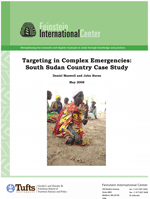The population of Southern Sudan was caught in a civil war from 1983 to 2005. During the war, several major famines led to a massive food aid intervention by the World Food Programme, which continues to the present. During the war, much of this food was delivered to vulnerable people by air drops, with the actual targeting of assistance on the ground left to traditional authorities. The main objective of targeting was to minimize exclusion. In the post-war era, the food aid program is shifting. There is still a general distribution modality for dealing with emergencies, and it has been adapted to accommodate the large flow of returned refugees and displaced people, going home after years or decades of being gone. However, unlike earlier programs, this one is targeted. Other modalities—food for work or education, and nutritional support, are also more targeted. This is making the targeting of food assistance much more administratively managed, and less participatory—contrary to much of the literature which suggests that community-based targeting is more difficult in conflict emergencies than in peace-time (or post-war transitions, as the current situation in Southern Sudan would most aptly be described). This more administrative approach to targeting is the result of GOSS policy—not simply a WFP choice.
This research is one case in a study commissioned by the World Food Programme to investigate the participation of recipient community in the targeting and management of humanitarian food assistance in complex emergencies. The study involved a substantial desk review of existing documentation, and three weeks of field work in February and March 2008. The purpose of the study was to understand the ways in which participatory or community-based approaches to targeting have been attempted, within the definition of community-based targeting suggested by WFP. The study was not an evaluation of targeting methods, although some critical examination of targeting was necessary in order to understand the constraints on community participation.

